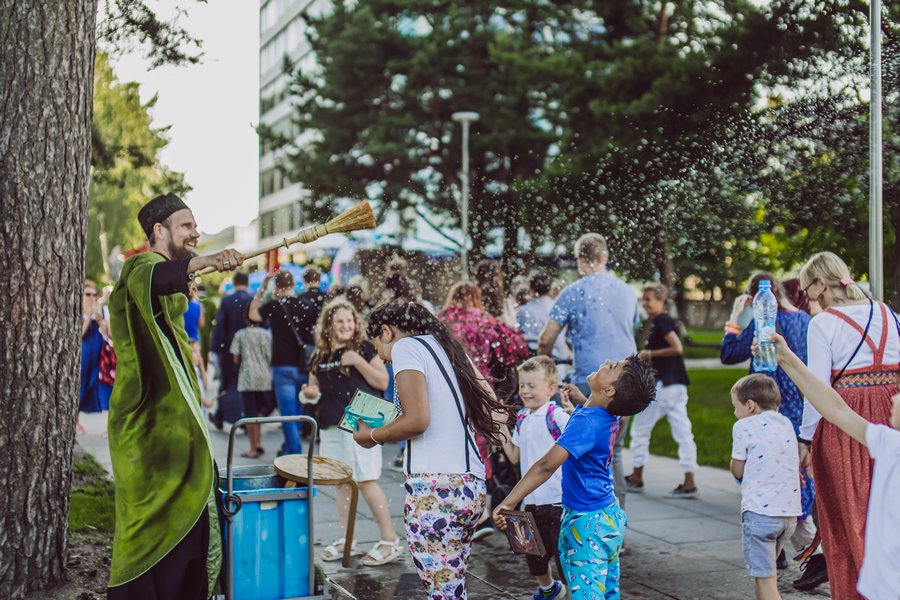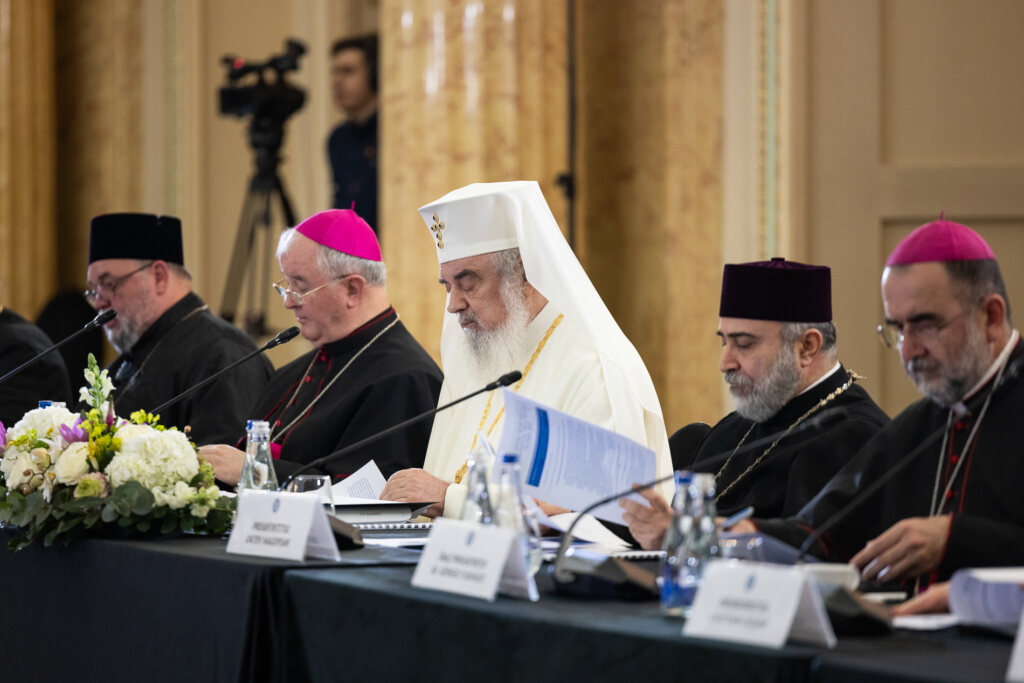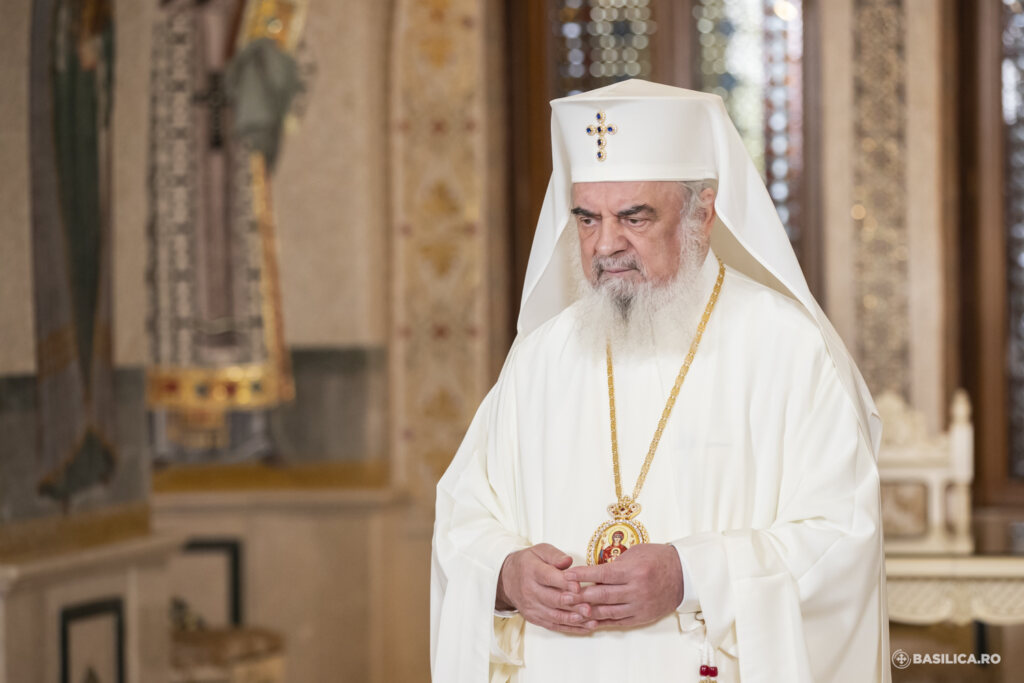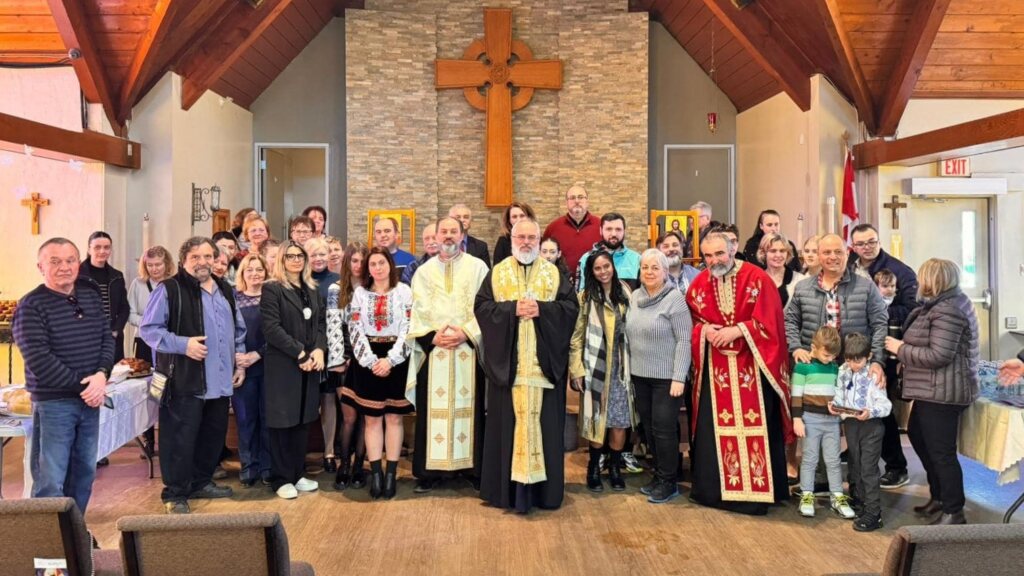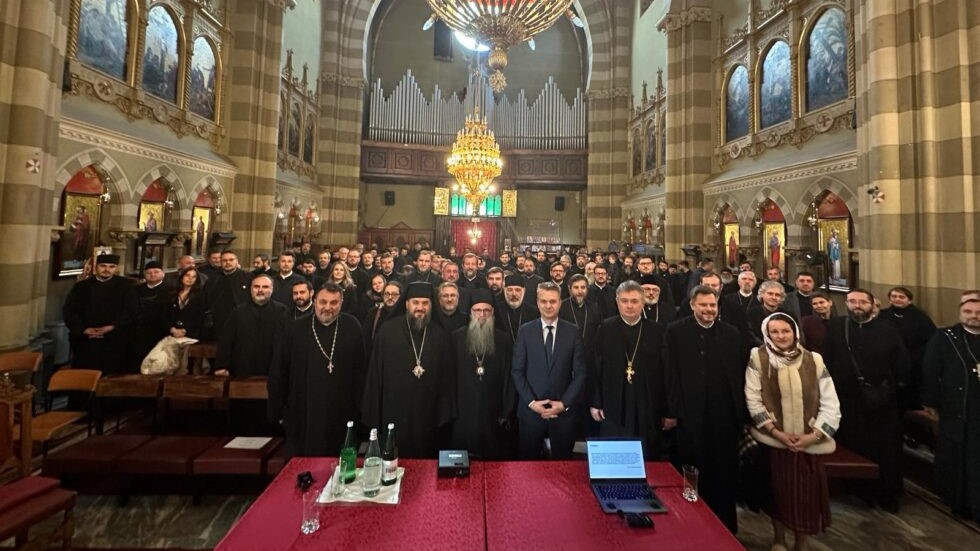Holy Apostle Bartholomew
He was born at Cana of Galilee and was one of the Twelve Apostles of Christ.
After the Descent of the Holy Spirit on the Day of Pentecost, it fell by lot to the holy Apostles Bartholomew and Philip (November 14) to preach the Gospel in Syria and Asia Minor. In their preaching they wandered through various cities, and then met up again. Accompanying the holy Apostle Philip was his sister, the holy virgin Saint Mariamnne.
Traversing the cities of Syria and Myzia, they underwent much hardship and tribulations, they were stoned and they were locked up in prison. In one of the villages they met up with the Apostle John the Theologian, and together they set off to Phrygia.
In the city of Hieropolis by the power of their prayers they destroyed an enormous viper, which the pagans worshipped as a god. The holy Apostles Bartholomew and Philip with his sister confirmed their preaching with many miracles.
At Hieropolis there lived a man by the name of Stachys, who had been blind for 40 years. When he received healing, he then believed in Christ and was baptized. News of this spread throughout the city, and a multitude of the people thronged to the house where the apostles were staying.
The sick and those beset by demons were released from their infirmities, and many were baptized. The city prefect gave orders to arrest the preachers and throw them in prison, and to burn down the house of Stachys. At the trial pagan priests came forth with the complaint that the strangers were turning people away from the worship of the ancestral gods.
Thinking that perhaps some sort of magic power was hidden away in the clothes of the apostles, the prefect gave orders to strip them. But Saint Mariamne became like a fiery torch before their eyes, and none dared touch her. They sentenced the saints to death.
The Apostle Philip was crucified upside down. Suddenly there was an earthquake, and a fissure in the earth swallowed up the prefect of the city, together with the pagan priests and many of the people. Others took fright and rushed to take down the apostles from the crosses.
Since the Apostle Bartholomew had not been suspended very high, they soon managed to take him down. The Apostle Philip, however, had died. After making Stachys Bishop of Hieropolis, the Apostle Bartholomew and Saint Mariamne left the city and moved on.
Preaching the Word of God, Mariamne arrived in Lykaonia, where she peacefully died (February 17). The Apostle Bartholomew went to India, where he translated the Gospel of Matthew into their language, and he converted many pagans to Christ.
He also visited Greater Armenia (the country between the River Kura and the upper stretches of the Tigrus and Euphrates Rivers), where he worked many miracles and healed the daughter of King Polymios from the demons afflicting her. In gratitude, the king sent gifts to the apostle, who refused to accept them, saying that he sought only the salvation of the souls of mankind.
Then Polymios together with his wife, daughter, and many of those close to them accepted Baptism. And people from more than ten cities of Greater Armenia followed their example.
But through the intrigues of the pagan priests, the Apostle Bartholomew was seized by the king’s brother Astiagus in the city of Alban (now the city of Baku), and crucified upside down. But even from the cross he did not cease to proclaim the good news about Christ the Savior.
Finally, on orders from Astiagus, they flayed the skin from the Apostle Bartholomew and cut off his head. Believers placed his relics in a leaden coffin and buried him.
In about the year 508 the holy relics of the Apostle Bartholomew were transferred to Mesopotamia, to the city of Dara. When the Persians seized the city in 574, Christians took the relics of the Apostle Bartholomew with them when they fled to the shores of the Black Sea.
But since the enemy overtook them there, they were compelled to leave the coffin behind, and the pagans threw it into the sea. By the power of God the coffin miraculously arrived on the island of Lipari.
In the ninth century, after the taking of the island by the Arabs, the holy relics were transferred to the Neapolitan city of Beneventum in Italy, and in the tenth century part of the relics were transferred to Rome.
The holy Apostle Bartholomew is mentioned in the Life of Saint Joseph the Hymnographer (April 4).
Having received from a certain man part of the relics of the Apostle Bartholomew, Saint Joseph conveyed them to his own monastery near Constantinople, and he built a church in the name of the Apostle Bartholomew, placing in it a portion of the relics. Saint Joseph ardently desired to compose hymns of praise in honor of the saint, and he fervently besought God to grant him the ability to do so.
On the Feast day in memory of the Apostle Bartholomew, Saint Joseph saw him at the altar. He beckoned to Joseph and took the holy Gospel from the altar table and pressed it to his bosom with the words, “May the Lord bless you, and may your song delight the whole world.”
And from that time Saint Joseph began to write hymns and canons to adorn not only the Feast day of the Apostle Bartholomew, but also the Feast days of many other saints, composing about 300 canons in all.
Saints John Chrysostom, Cyril of Alexandria, Epiphanius of Cyprus and certain other teachers of the Church regard the Apostle Bartholomew as being the same person as Nathanael (John 1:45-51, 21:2).
Troparion — Tone 3
Holy Apostles Bartholomew and Barnabas, / entreat the merciful God / to grant our souls forgiveness of transgressions.
Holy Apostle Barnabas of the Seventy
He was born on the island of Cyprus into the family of the tribe of Levi, and he was named Joseph. He received his education at Jerusalem, being raised with his friend and fellow student Saul (the future Apostle Paul) under the renowned teacher of the Law, Gamaliel.
Joseph was pious, he frequented the Temple, he strictly observed the fasts and avoided youthful distractions. During this time period our Lord Jesus Christ began His public ministry. Seeing the Lord and hearing His Divine Words, Joseph believed in Him as the Messiah. Filled with ardent love for the Savior, he followed Him.
The Lord chose him to be one of His Seventy Apostles. The other Apostles called him Barnabas, which means “son of consolation.” After the Ascension of the Lord to Heaven, Barnabas sold land belonging to him near Jerusalem and he brought the money to the feet of the Apostles, leaving nothing for himself (Acts 4:36-37).
When Saul arrived in Jerusalem after his conversion and sought to join the followers of Christ, everyone there was afraid of him since he had persecuted the Church only a short while before. Barnabas, however, came with him to the Apostles and reported how the Lord had appeared to Saul on the road to Damascus (Acts 9:26-28).
Saint Barnabas went to Antioch to encourage the believers, “Having come and having seen the grace of God, he rejoiced and he urged all to cleave to the Lord with sincerity of heart” (Acts 11:23). Then he went to Tarsus, and brought the Apostle Paul to Antioch, where for about a year they taught the people.
It was here that the disciples first began to be called Christians (Acts 11:26). With the onset of famine, and taking along generous alms, Paul and Barnabas returned to Jerusalem.
When King Herod killed Saint James the son of Zebedee, and had the Apostle Peter put under guard in prison to please the Jews, Saints Barnabas and Paul and Peter were led out of the prison by an angel of the Lord.
They hid out at the house of Barnabas’ aunt Maria. Later, when the persecution had quieted down, they returned to Antioch, taking with them Maria’s son John, surnamed Mark.
Under the inspiration of the Holy Spirit, the prophets and teachers there imposed hands upon Barnabas and Paul, and sent them off to do the work to which the Lord had called them (Acts 13:2-3). Arriving in Seleucia, they sailed off to Cyprus and in the city of Salamis they preached the Word of God in the Jewish synagogues.
On Paphos they came across a sorcerer and false prophet named Bar-Jesus, who was close with the proconsul Sergius. Wishing to hear the Word of God, the proconsul invited the saints to come to him. The sorcerer attempted to sway the proconsul from the Faith, but the Apostle Paul denounced the sorcerer, who through his words suddenly fell blind. The proconsul believed in Christ (Acts 13:6-12).
From Paphos Barnabas and Paul set sail for Pergamum of Pamphylia, and then they preached to the Jews and the Gentiles at Pisidian Antioch and throughout all that region. The Jews rioted and expelled Paul and Barnabas.
The saints arrived in Iconium, but learning that the Jews wanted to stone them, they withdrew to Lystra and Derben. There the Apostle Paul healed a man, crippled in the legs from birth. The people assumed them to be the gods Zeus and Hermes and wanted to offer them sacrifice. The saints just barely persuaded them not to do this (Acts 14:8-18).
When the question arose whether those converted from the Gentiles should accept circumcision, Barnabas and Paul went to Jerusalem. There they were warmly received by the Apostles and elders. The preachers related “what God had wrought with them and how He had opened the door of faith to the Gentiles” (Acts 14:27).
After long deliberations the Apostles collectively resolved not to impose any sort of burden upon Gentile Christians except what was necessary: to refrain from the pollutions of idols, and from fornication, and from things strangled, and from blood (Acts 15:19-20).
Letters were sent with Barnabas and Paul, and they again preached at Antioch, and after a certain while they decided to visit the other cities where they had visited earlier.
Saint Barnabas wanted to take Mark along with him, but Saint Paul did not want to, since earlier he had left them. A quarrel arose, and they separated. Paul took Silas with him and went to Syria and Cilicia, while Barnabas took Mark with him to Cyprus (Acts 15:36-41).
Having multiplied the number of believers, Saint Barnabas traveled to Rome, where he was perhaps the first to preach Christ.
Saint Barnabas founded the episcopal see at Mediolanum (now Milan), and upon his return to Cyprus he continued to preach about Christ the Savior. Then the enraged Jews incited the pagans against Barnabas, and they led him out beyond the city and stoned him, and then built a fire to burn the body.
Later on, having come upon this spot, Mark took up the unharmed body of Saint Barnabas and buried it in a cave, placing upon the saint’s bosom, in accord with his final wishes, the Gospel of Matthew which he had copied in his own hand.
Saint Barnabas died in about the year 62, at age seventy-six. In time, the burial spot was forgotten, but numerous signs took place at this spot. In the year 448, during the time of the emperor Zeno, Saint Barnabas appeared three times in a dream to Archbishop Anthimus of Cyprus and indicated the place where his relics were buried.
Starting to dig at the indicated spot, Christians found the incorrupt body of the saint, and upon his chest was the Holy Gospel.
It was during this time that the Church of Cyprus began to be regarded as Apostolic in origin, and received the right of choosing its head.
Thus Saint Barnabas defended Cyprus against the pretensions of the opponent of the Fourth Ecumenical Council, the heretic surnamed Knapheios, who had usurped the patriarchal throne at Antioch and tried to gain dominion over the Church of Cyprus.
Saint Luke of Crimea
Saint Luke, Bishop of Simferopol and Crimea, the Blessed Surgeon, was born Valentin Felixovich Voino-Yasenetsky in April 14, 1877.
Doctor of Medicine, Professor, and State Prize winner, since 1944 he was the Archbishop of Tambov and Michurinsk, and later of Simferopol and the Crimea. While he was serving the church as an Archbishop, he was also practicing as a surgeon and taught and published many books and articles on regional anesthesia and surgery. He is now known to be a world-famous pioneering surgeon.
In November of 1995 he was announced as a Saint by the Ukrainian Orthodox Church, and was officially glorified by the Patriarchate of Russia May 25, 1996. He is commemorated by the church June 11 the anniversary of his falling asleep in the Lord.
Born with the name Valentine Felixovitch Voino-Yassentsky on April 27, 1877 in Kerch (east Crimea), his family members were civil servants to Lithuanian and Polish Kings. The family was impoverished over time but Saint Luke remembers that he received his religious inheritance from his pious father. His first true understanding of the Christian faith came from the New Testament given to him at his high school graduation by his principal.
He had an outstanding secular training. Having exceptional drawing abilities, he graduated the Kiev Academy of Fine Arts. He decided however against pursuing art in favor of a career where he could help people who suffer, and chose to be a physician.
In 1903 at the age of 26, he graduated from Great Prince St. Vladimir Medical School at the University of Kiev, and for a long time worked as a local district physician. An extraordinary medical student, he excelled at anatomy. His superior knowledge of anatomy served him throughout his surgical career.
Out of compassion to the blindness that beggars were experiencing due to trachoma, Saint Luke studied ophthalmology at the Kiev ophthalmologic clinic. In a very short time he acquired a significant amount of ophthalmologic training. His knowledge of this subspecialty helped him treat not only his trachoma patients, but many other serious eye conditions as well.
Another important event in Valentine’s life was the marriage to his wife Anna, a nurse. They had four children. The family was transferred frequently to various regional health care facilities and from the very beginning Valentine never requested funds from his patients, nor would he turn anyone away because of his ethnic background or personal beliefs. When his wife died, God in setting the path for Valentine’s Sainthood provided the family with Sofia Sergeevna who would be the joyful surrogate mother of his children during the harsh times ahead. Valentine never remarried.
During his early career he published many scientific treatises and eventually became the head surgeon and professor of surgery at the hospital in Tashkent in March 1917. In October, Lenin took over the government and civil war erupted in Tashkent in January 1919. Lenin’s government disfavored any religious witness. Valentine was under constant threat, especially when treating party members but he refused to operate under any circumstances without the Icon of the Mother of God. His results were outstanding.
“I ought to tell you that what God did to me as amazing and incomprehensible…My pursuing surgery completely satisfied the goal I always had to serve the poor and the suffering, to dispose all my strength for the comfort of their pains, and to help them in their needs.”
These are some of the introductory comments from the memoirs of Saint Luke, that were kept by his secretary, E.P. Leikfeld. His words are not vainglorious, but a commentary on how God’s plan was fulfilled through the life and example of Saint Luke. Living in the Ukraine during the oppressive period of communism, St. Luke stood out among his fellow physicians both as a surgeon and as a Christian. Even the communists coveted his talents for healing the body.
Despite the dangers from the Lenin regime he fearlessly attended theological discussions arranged by Archpriest Mikhail Andeev. During this period when clergymen and pious people would prove their faith in blood, providence led the Archpriest to invite Valentine to the priesthood. Thus in 1921 at the age of 44 Valentine was ordained a priest. For two years, this exceptional individual was active not only in his pastoral work but in public and scientific activity.
Eventually Fr. Valentine was arrested and put on trial, falsely accused of giving inappropriate surgical care to injured Red Army soldiers. At his trial in his characteristic fearless way he denounced the prosecutors claims by explaining:
“I cut people to save them. You, Mr. Public Prosecutor, why do you cut their heads off?”
Certainly the charges were never proven but since the Party had to be infallible Fr. Valentine was convicted to sixteen years imprisonment.
Towards the end of his life he was worried if it would be permitted to chant “Holy God” at his funeral. He last celebrated the Divine Liturgy on the feast of the Nativity of Christ in 1960, and his last sermon was on Forgiveness Sunday. His repose was June 11, 1961, the day of commemoration for “All Saints who shone forth in the Land of Russia”.
The government made every effort to make Saint Luke’s funeral as inconspicuous as possible. Buses were provided to hurry the funeral procession along the side-streets to the gravesite so there would be little fanfare and recognition. God had different plans for Saint Luke and a popular uprising occurred at the funeral. The faithful refused to be hurried. They boldly ignored, at peril to life and limb, the roadblocks to the central corridors. The mayor was angered because of the roses spread on the roads, and flung a basket away claiming that the roses were litter and trash on the streets. To the dismay of the government and to avoid an uprising, they conceded to allow the funeral to proceed for three and a half hours without interference. The roads were full and cars stopped everywhere. People had climbed on balconies, onto rooftops of houses. Such a funeral was a tribute of honor. The authorities wanted a silent event. It was witness to God’s Glory that throughout the walk there was a constant chant of “Holy God, Holy Mighty, Holy Immortal have mercy on us”.
Saint Luke’s prayers to have “Holy God” chanted at his funeral during the atheistic times were answered!
On March 17, 1996, St. Luke’s remains were disinterred, with an estimated 40,000 people taking part. It is said that an indescribable aroma arose from his relics, while his heart was discovered incorrupt, a testament to the great love he bore towards Christ and his fellow men. Three days later on March 20, 1996, his relics were transferred to the Church of the Holy Trinity.
His relics continue to work countless miracles, in the Church of the Holy Trinity in Simferopol, at Sagmata Monastery in Greece, and throughout the world.


